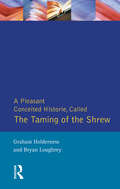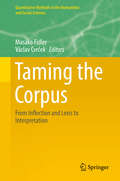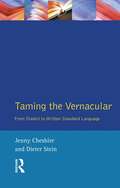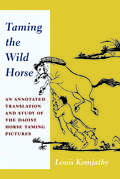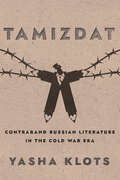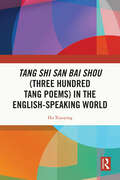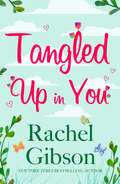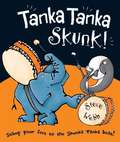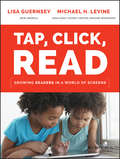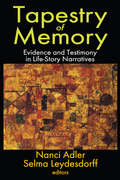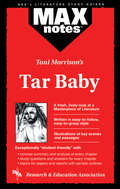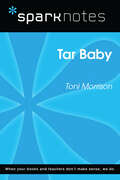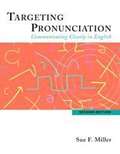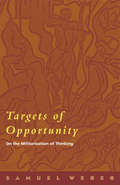- Table View
- List View
Taming of the Shrew: First Quarto of "Taming of a Shrew" (Shakespearean Originals--first Editions Ser.)
by Graham Holderness Bryan LoughreyFirst Published in 1992. This series puts into circulation single annotated editions of early modern play-texts whose literary and theatrical histories have been overshadowed by editorial practices dominant since the eighteenth century. The text contained in this volume is not what we know as Shakespeare's The Taming of the Shrew, modern editions of which play are all derived from the text printed in the 1623 First Folio edition of Shakespeare's works. The present text is an edition of the play published in 1594 under the title The Taming of a Shrew, which has always been denied the authorising signature of 'Shakespeare', and regarded as an earlier version by another dramatist or as a pirated and corrupt 'memorial reconstruction' of Shakespeare's The Taming of the Shrew.
Taming the Corpus: From Inflection and Lexis to Interpretation (Quantitative Methods in the Humanities and Social Sciences)
by Masako Fidler Václav CvrčekThis book bridges the current quantitative and qualitative text analyses, using grammar as a crucial source of investigation. Taking data from Czech, an inflected language, in which the most optimal conditions to respond to this research question are met, the book expands the understanding of language and text in ways that have not been executed before. For predominantly English-based quantitative research, this volume fills a crucial gap by examining the relationship between inflection and other phenomena (including discourse, translation and literature). For the current qualitative research, the volume provides large empirical data to confirm some of its claims, but more importantly, it demonstrates the important role of detailed grammatical concepts that have not been considered before. Besides addressing fundamental questions about text analysis methods, the volume presents a diverse array of Czech data that are unique in their own right and worthy of dissemination to the general audience. Taming the Corpus: From Inflection and Lexis to Interpretation is divided into three sections. Section 1 deals with phonotactics, poetic structure, morphological complexity used to differentiate literary style, and native speakers’ sense of grammaticality – issues pertinent to linguistic typology, cognition and language, and literary studies. Section 2 focuses on inter-language relations, especially the theory of translation. Section 3 demonstrates how quantitative analysis of texts can contribute to our understanding of society and connects the volume to legal language, construction of gender and discourse position and implicit ideology.
Taming the Vernacular: From dialect to written standard language
by Jenny Cheshire Dieter SteinTaming the Vernacular: From Dialect to Written Standard Language examines the differences between 'standard' and 'nonstandard' varieties of several different languages. Not only are some of the best-known languages of Europe represented here, but also some that have been less well-researched in the past. The chapters address the syntax of Dutch, English, French, Finnish, Galician, German and Spanish. For these languages, and many others, it is the standard varieties on which the most extensive syntactic research has been carried out, with the result that very little is known about the syntax of their dialects or the spoken colloquial varieties. The editors of this volume seek to redress the balance by taking a cross-linguistic perspective on the historical development of the standardised varieties. This allows them to identify some common characteristics of spoken language. It also helps the reader to understand the kinds of filtering processes that are involved in standardization, which result in the syntax of spoken colloquial language being different from the syntax of the standard varieties.Taming the Vernacular: From Dialect to Written Standard Language is suitable for undergraduate and postgraduate students of Linguistics, particularly those taking courses in sociolinguistics, dialectology, and historical linguistics. The focus on a variety of languages also makes this text suitable for students studying courses which cover the linguistic aspects of European languages.
Taming the Wild Horse: An Annotated Translation and Study of the Daoist Horse Taming Pictures
by Louis KomjathyIn thirteenth-century China, a Daoist monk named Gao Daokuan (1195-1277) composed a series of illustrated poems and accompanying verse commentary known as the Daoist Horse Taming Pictures. In this annotated translation and study, Louis Komjathy argues that this virtually unknown text offers unique insights into the transformative effects of Daoist contemplative practice. Taming the Wild Horse examines Gao's illustrated poems in terms of monasticism and contemplative practice, as well as the multivalent meaning of the "horse" in traditional Chinese culture and the consequences for both human and nonhuman animals.The Horse Taming Pictures consist of twelve poems, ten of which are equine-centered. They develop the metaphor of a "wild" or "untamed" horse to represent ordinary consciousness, which must be reined in and harnessed through sustained self-cultivation, especially meditation. The compositions describe stages on the Daoist contemplative path. Komjathy provides opportunities for reflection on contemplative practice in general and Daoist meditation in particular, which may lead to a transpersonal way of perceiving and being.
Tamizdat: Contraband Russian Literature in the Cold War Era (NIU Series in Slavic, East European, and Eurasian Studies #86)
by Yasha Yakov KlotsTamizdat offers a new perspective on the history of the Cold War by exploring the story of the contraband manuscripts sent from the USSR to the West. A word that means publishing "over there," tamizdat manuscripts were rejected, censored, or never submitted for publication in the Soviet Union and were smuggled through various channels and printed outside the country, with or without their authors' knowledge. Yasha Klots demonstrates how tamizdat contributed to the formation of the twentieth-century Russian literary canon: the majority of contemporary Russian classics first appeared abroad long before they saw publication in Russia.Examining narratives of Stalinism and the Gulag, Klots focuses on contraband manuscripts in the 1960s and 70s, from Khrushchev's Thaw to Stagnation under Brezhnev. Klots revisits the traditional notion of late Soviet culture as a binary opposition between the underground and official state publishing. He shows that even as tamizdat represented an alternative field of cultural production in opposition to the Soviet regime and the dogma of Socialist Realism, it was not devoid of its own hierarchy, ideological agenda, and even censorship. Tamizdat is a cultural history of Russian literature outside the Iron Curtain. The Russian literary diaspora was the indispensable ecosystem for these works. Yet in the post-Stalin years, they also served as a powerful weapon on the cultural fronts of the Cold War, laying bare the geographical, stylistic, and ideological rifts between two disparate yet inextricably intertwined fields of Russian literature, one at home, the other abroad.Open Access edition funded by the National Endowment for the Humanities.
Tang Shi San Bai Shou (Three Hundred Tang Poems) in the English-Speaking World
by Hu XiaoyingThis book examines six English translations of Tang Shi San Bai Shou (Three Hundred Tang Poems), the renowned anthology of Tang poetry, and explores the challenges and strategies involved in conveying the essence of classical Chinese poetry to an English-speaking audience.As a classic anthology, Tang Shi San Bai Shou captures the linguistic features, unique expressions and traditional culture of ancient Chinese verse. Since its publication in the Qing dynasty, it has circulated widely in China and extended its influence to the English-speaking world, with a rich history of translation and dissemination. This book unravels the complexities of translating classical Chinese poetry and highlights the different approaches taken by translators of different periods and backgrounds by comparing six complete translations. The book discusses the linguistic, cultural and artistic characteristics of Tang poetry, and readers can see how these challenges and the gaps between ancient Chinese poetry and modern English audiences are bridged by the ongoing efforts of translators.Scholars and students of classical Chinese literature and translation studies, as well as Chinese-English translators and Chinese poetry enthusiasts, will find this book a useful reference. Readers interested in Chinese culture will be led into the poetic world of ancient China.
Tangled Up In You: A fabulously funny rom-com (Writer Friends)
by Rachel GibsonTangled Up In You is a fabulously funny rom-com from New York Times bestseller Rachel Gibson - perfect for fans of Jill Shalvis, Jo Watson and Christina Lauren.When Maddie Dupree enters Hennessy's Bar in Truly, Idaho, she isn't looking for a husband, a boyfriend, or even just a drink. She's looking for the truth about her past, and nothing will stand in her way. Especially not a Hennessy boy. Everyone knows Mick Hennessy is irresistible. So far, he's managed to keep the ladies in line, but when he claps eyes on gorgeous Maddie, he just can't help getting involved. But Maddie's keeping secrets about why she's in town - and when those secrets are revealed, there'll be a whole lot of trouble in Truly...Check out the rest of Rachel's addictive titles, including Sex, Lies and Online Dating, I'm In No Mood For Love and Not Another Bad Date.
Tanka Tanka Skunk
by Steve WebbRhyming has never been so much fun as in Steve Webb's bold, new picture book, which encourages children to read aloud, following the easy and catchy rhythm of the text. "Skunka Tanka Skunka Tanka Tanka Tanka Skunk! They've got the beat, and so do their friends." "Meet Tanka and his friend, Skunk. When you say their names together, they sound like drums!" Steve Webb's innovative and visually stunning picture book introduces young readers to simple rhythms with this riot of shout-out-loud words and cavorting animals. TANKA TANKA SKUNK! makes reading tons of fun as the text and the illustrations leap and dance across the pages.
Tap, Click, Read
by Lisa Guernsey Michael H. LevineWith young children gaining access to a dizzying array of games, videos and other digital media, will they ever learn to read? The answer is yes - if we ensure that the media at children's fingertips is harnessed to promote the skills and knowledge that enable reading, instead of undermining them. Tap, Click, Read helps educators and parents become more successful at supporting young children's early literacy skills in the "digital wild west." With compelling text, videos, and interactive graphics, the book answers such questions as: In what ways could new technologies promote the adult-child interactions that help children develop language and literacy skills that help them become strong readers? Who are the pioneers in this field? What will it take to create a future in which parents and teachers become adept at using media to build a foundation for children's reading? Beyond traditional literacy, what are the digital competencies that today's young children will need to master in an increasingly complex and interconnected world? The authors provide findings from an ongoing examination of the app marketplace that identifies bright spots and pitfalls--a first-of-its-kind analysis, providing statistics on what kind of reading and other early learning apps are on offer in the free-for-all of the Apple app store and Google Play marketplaces. They also provide toolkits (such as e-media resource lists and community audit worksheets) for schools and community organizations to use as they foster literacy-focused relationships with parents and build high-tech learning spaces for tomorrow's readers. Rather than telling parents and teachers to push technology to the margins, Tap, Click, Read shows them how to put technology to work in serving children's needs and helping to address the crippling problem of low reading skills across the country.
Tapestry of Memory: Evidence and Testimony in Life-Story Narratives (Memory And Narrative Ser.)
by Nanci Adler Selma LeydesdorffIn this volume, contributors present narratives and explore the way they influence the perception of the past. While acknowledging the debate about the validity of qualitative research based on narratives, this volume aims to illuminate how truth and evidence form part of a much wider debate on the representation of history.The volume includes the work of historians but the interdisciplinary nature of the contributions shows that the validity debate also applies to the broader fields of cultural studies, sociology, and other social sciences. The distinction between memory and testimony is a crucial theme. Memory, though selective, is the basis of testimony. Testimony provides an audience with information that becomes evidence of what was seen or experienced. Such evidence can form the basis of legal truth.Nanci Adler and Selma Leydesdorff divide the volume into three core sections: Official Testimony and Other Facts and Evidence; The Creation of New History and the Integration of Collective Memory in the Story of One's Self; and Claims Based on Narratives vs. Official History. After a comprehensive introduction by the editors, the volume offers twelve essays by leading scholars. This work is a new offering in Transaction's acclaimed Memory and Narrative series.
Tar Baby (MAXnotes Literature Guides)
by Ann WilsonREA's MAXnotes for Toni Morrison's Tar Baby MAXnotes offer a fresh look at masterpieces of literature, presented in a lively and interesting fashion. Written by literary experts who currently teach the subject, MAXnotes will enhance your understanding and enjoyment of the work. MAXnotes are designed to stimulate independent thought about the literary work by raising various issues and thought-provoking ideas and questions. MAXnotes cover the essentials of what one should know about each work, including an overall summary, character lists, an explanation and discussion of the plot, the work's historical context, illustrations to convey the mood of the work, and a biography of the author. Each section of the work is individually summarized and analyzed, and has study questions and answers.
Tar Baby (SparkNotes Literature Guide Series)
by SparkNotesTar Baby (SparkNotes Literature Guide) by Toni Morrison Making the reading experience fun! Created by Harvard students for students everywhere, SparkNotes is a new breed of study guide: smarter, better, faster. Geared to what today's students need to know, SparkNotes provides: *Chapter-by-chapter analysis *Explanations of key themes, motifs, and symbols *A review quiz and essay topicsLively and accessible, these guides are perfect for late-night studying and writing papers
Target Spelling 1020
by Margaret M. Scarborough Mary F. Brigham Teresa A. MillerThis is an English Spelling book.
Target Spelling 1260
by Margaret M. Scarborough Mary F. Brigham Teresa A. MillerAn English Spelling book.
Target Spelling 180
by Margaret M. Scarborough Mary F. Brigham Teresa A. MillerAn easy to read English Spelling book.
Target Spelling 540
by Margaret M. Scarborough Mary F. Brigham Teresa A. MillerThis book is an English Spelling book.
Target Spelling 780
by Margaret M. Scarborough Mary F. Brigham Teresa A. MillerThis is an English Spelling book.
Target: Reading Comprehension (Grade 5) (First Edition) (Common Core Support Coach)
by Triumph Learning Llc.Targeting Pronunciation: Communicating Clearly in English (Second Edition)
by Sue F. MillerA comprehensive program for providing intermediate and advanced ESL students with the tools they need to communicate clearly in English. Using a communicative and interactive approach, the text provides extensive listening and practice with all aspects of pronunciation. This new edition, while updated, retains all the popular features of the original text. Targeting Pronunciation is organized around eight practical pronunciation goals, or targets. Most of these targets are suprasegmentals (stress, intonation, and speech rhythm). Segmentals (consonants and vowels) are also well covered, both in the text and in appendixes A and B. The targets presented early in the book are recycled throughout the chapters as students gain speaking experience and confidence.
Targets of Opportunity: On the Militarization of Thinking
by Samuel WeberThe title of this book echoes a phrase used by the Washington Post to describethe American attempt to kill Saddam Hussein at the start of the war againstIraq. Its theme is the notion of targeting (skopos) as the name of an intentionalstructure in which the subject tries to confirm its invulnerability by aiming todestroy a target. At the center of the first chapter is Odysseus’s killing of the suitors;the second concerns Carl Schmitt’s Roman Catholicism and Political Form; thethird and fourth treat Freud’s “Thoughts for the Times on War and Death” and“The Man Moses and Monotheistic Religion.” Weber then traces the emergenceof an alternative to targeting, first within military and strategic thinking itself(“Network Centered Warfare”), and then in Walter Benjamin’s readings of“Capitalism as Religion” and “Two Poems of Friedrich Hölderlin.”
Tarjetas de fotos [Grados 1–2] (¡Arriba la Lectura!)
by Houghton Mifflin Harcourt Publishing CompanyNIMAC-sourced textbook
Tarjetas de letras [ Grados 1-2] (¡Arriba la Lectura!)
by Houghton Mifflin Harcourt Publishing CompanyNIMAC-sourced textbook
Tarjetas de palabras [Grados 1 y 2] (¡Arriba la Lectura!)
by Houghton Mifflin Harcourt Publishing CompanyNIMAC-sourced textbook
